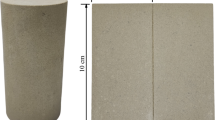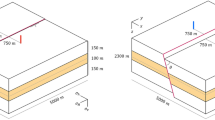Abstract
FALCON (Fracturing And Liquid CONvection) is a hybrid continuous/discontinuous Galerkin finite element geothermal reservoir simulation code based on the MOOSE (Multiphysics Object-Oriented Simulation Environment) framework being developed and used for multiphysics applications. In the present work, a suite of verification and validation (V&V) test problems for FALCON was defined to meet the design requirements, and solved to the interests of enhanced geothermal system modeling and simulation. The intent for this test problem suite is to provide baseline comparison data that demonstrates the performance of FALCON solution methods. The test problems vary in complexity from a single mechanical or thermal process, to coupled thermo-hydro-mechanical processes in geological porous medium. Numerical results obtained by FALCON agreed well with either the available analytical solutions or experimental data, indicating the verified and validated implementation of these capabilities in FALCON. Whenever possible, some form of solution verification has been attempted to identify sensitivities in the solution methods, and suggest best practices when using the FALCON code.


















Similar content being viewed by others
Abbreviations
- c w :
-
Specific heat capacity of fluid (J kg −1 K−1)
- c r :
-
Specific heat capacity of rock (J kg −1 K−1)
- g :
-
Magnitude of gravitational force (m s−2)
- K m :
-
Average thermal conductivity of the porous medium (W m−1 K−1)
- k :
-
Reservoir intrinsic permeability (m2)
- Pe h :
-
Element Peclet number
- p :
-
Fluid pressure (Pa)
- \( \acute{Q} \) :
-
Thermal energy source/sink (J s−1)
- q :
-
Flux (Darcy velocity) vector (m s −1)
- \( \acute{q} \) :
-
Specific mass source/sink (or injection/production rate) (kg m−3 s−1)
- T :
-
Fluid temperature (K)
- t :
-
Time (s)
- u :
-
Displacement vector (with three components) (m)
- α :
-
Biot effective stress coefficient
- β :
-
Thermal expansion coefficient
- μ :
-
Fluid viscosity (Pa s)
- ρ :
-
Fluid density (kg m−3)
- ρ r :
-
Rock density (kg m−3)
- \( \sigma \) :
-
Second-rank stress tensor (with six unknown components) (Pa)
- ϕ :
-
Reservoir porosity
- ∇:
-
Vector differential operator (m−1)
References
Avdonin NA (1964) Some formulas for calculating the temperature field of a stratum subject to thermal injection. Neft’i Gaz 3:37–41
Bahrami D, Danko G, Fu P, Guo B, Podgorney R, White M, Xia Y (2015). Poroelastic and Self-Propped Single Fracture THM Models for EGS Studies. In: proceedings of the 40th Stanford Geothermal Workshop, Stanford, California, USA
Balay S, Abhyankar S, Adams M, Brown J, Brune P, Buschelman K et al. (2014). PETSc Users Manual Revision 3.5 (No. ANL-95/11 Rev. 3.5), Argonne National Laboratory
Brooks AN, Hughes TJ (1982) Streamline upwind/petrov-galerkin formulations for convection dominated flows with particular emphasis on the incompressible Navier-stokes equations. Comput Methods Appl Mech Eng 32(1):199–259
Brownell DH, Garg SK, Pritchett JW (1977) Governing equations for geothermal reservoirs. Water Resour Res 13(6):929–934
Chaplin, M. (2011). Water Structure and Science. Website http://www.lsbu.ac.uk/water/anmlies.html. Accessed 18 Feb 2016
Cockburn B, Karniadakis GE, Shu CW (2000) The development of discontinuous Galerkin methods. Springer, Berlin Heidelberg, pp 3–50
Cooper JR, Dooley RB (2008). Release of the IAPWS formulation 2008 for the viscosity of ordinary water substance
Elder JW (1967) Transient convection in a porous medium. J Fluid Mech 27(03):609–623
Faust CR, Mercer JW (1979a) Geothermal reservoir simulation: 1. Mathematical models for liquid- and vapor-dominated hydrothermal systems. Water Resour Res 15(1):23–30
Faust CR, Mercer JW (1979b) Geothermal reservoir simulation: 2. Numerical solution techniques for liquid- and vapor-dominated hydrothermal systems. Water Resour Res 15(1):31–46
Gaston D, Newman C, Hansen G, Lebrun-Grandie D (2009) MOOSE: a parallel computational framework for coupled systems of nonlinear equations. Nucl Eng Des 239(10):1768–1778
Graf T (2009). Simulation of geothermal flow in deep sedimentary basins in Alberta. Alberta Energy Resources Conservation Board
Hascoet L, Pascual V (2013) The Tapenade Automatic Differentiation tool: principles, model, and specification. ACM Trans Math Softw (TOMS) 39(3):20
Heroux MA, Bartlett RA, Howle VE, Hoekstra RJ, Hu JJ, Kolda TG et al (2005) An overview of the Trilinos project. ACM Trans Math Softw (TOMS) 31(3):397–423
Hughes TJ, Mallet M, Akira M (1986) A new finite element formulation for computational fluid dynamics: II. Beyond SUPG. Comput Methods Appl Mech Eng 54(3):341–355
ITASCA Consulting Group (1997). FALC 3D, Fast Lagrangian Analysis of Continua in 3 Dimensions, Version 2.0
Jaeger JC, Cook NG, Zimmerman R (2009). Fundamentals of Rock Mechanics. Wiley
Knoll DA, Keyes DE (2004) Jacobian-free Newton-Krylov methods: a survey of approaches and applications. J Comput Phys 193(2):357–397
Luo H, Xia Y, Li S, Nourgaliev R, Cai C (2012) A Hermite WENO reconstruction-based discontinuous Galerkin method for the Euler equations on tetrahedral grids. J Comput Phys 231(16):5489–5503
Luo H, Xia Y, Spiegel S, Nourgaliev R, Jiang Z (2013) A reconstructed discontinuous Galerkin method based on a Hierarchical WENO reconstruction for compressible flows on tetrahedral grids. J Comput Phys 236:477–492
Oldenburg CM, Pruess K (1995) Dispersive transport dynamics in a strongly coupled groundwater-brine flow system. Water Resour Res 31(2):289–302
Podgorney R, Huang H, Gaston D (2010) A fully coupled, implicit, finite element model for simultaneously solving multiphase fluid flow, heat transport, and rock de-formation. Geotherm Resour Counc Trans 34:427–432
Podgorney RK, Huang H, Lu C, Gaston D, Permann C, Guo L, Andrs D (2011) FALCON: a physics-based, massively parallel, fully-coupled, finite element model for simultaneously solving multiphase fluid flow, heat transport, and rock deformation for geothermal reservoir simulation, Idaho National Laboratory Report. Idaho National Laboratory Report INL/EXT-11-23351
Pollard DD, Holzhausen G (1979) On the mechanical interaction between a fluid- filled fracture and the earth’s surface. Tectonophysics 53(1):27–57
Pruess K, Oldenburg CM, Moridis GJ (1999) TOUGH2 User’s Guide Version 2. Lawrence Berkeley National Laboratory
Reed WH, Hill TR (1973) Triangular Mesh Methods for the Neutron Transport Equation. Technical Report LA-UR-73-479, Los Alamos Scientific Laboratory
Rutqvist J, Wu YS, Tsang CF, Bodvarsson G (2002) A modeling approach for analysis of coupled multiphase fluid flow, heat transfer, and deformation in fractured porous rock. Int J Rock Mech Min Sci 39(4):429–442
Trangenstein JA (2009) Numerical solution of hyperbolic partial differential equations. Cambridge University
Wagner W, Cooper JR, Dittmann A, Kijima J, Kretzschmar HJ, Kruse A, Willkommen T (2000) The IAPWS industrial formulation 1997 for the thermodynamic properties of water and steam. J Eng Gas Turbines Power 122(1):150–184
Xia Y, Podgorney R (2015) FALCON, an open-source geothermal reservoir simulation code. Retrieved from https://github.com/idaholab/falcon
Xia Y, Liu X, Luo H (2014a) A Finite Volume Method Based on WENO Reconstruction for Compressible Flows on Hybrid Grids. In: proceedings of the 52nd AIAA Aerospace Sciences Meeting, AIAA Paper No. 2014-0939, National Harbor, Maryland, USA
Xia Y, Luo H, Frisbey M, Nourgaliev R (2014b) A set of parallel, implicit methods for a reconstructed discontinuous Galerkin method for compressible flows on 3D hybrid grids. Comput Fluids 98:134–151
Acknowledgments
The work described in this paper was supported by the U.S. Department of Energy, under DOE Idaho Operations Office Contract. Accordingly, the U.S. Government retains a nonexclusive, royalty-free license to publish or reproduce the published form of this contribution, or allow others to do so, for U.S. Government purposes. This information was prepared as an account of work associated by an agency of the U.S. Government. Neither the U.S. Government nor any agency thereof, nor any of their employees, makes any warranty, express or implied, or assumes any legal liability or responsibility for the accuracy, completeness, or usefulness of any information, apparatus, product, or process disclosed, or represents that its use would not infringe privately owned rights. References herein to any specific commercial product, process, or service by trade name, trademark, manufacturer, or otherwise, does not necessarily constitute or imply its endorsement, recommendation, or favoring by the U.S. Government or any agency thereof. The views and opinions of authors expressed herein do not necessarily state or reflect those of the U.S. Government or any agency thereof.
Author information
Authors and Affiliations
Corresponding author
Rights and permissions
About this article
Cite this article
Xia, Y., Podgorney, R. & Huang, H. Assessment of a Hybrid Continuous/Discontinuous Galerkin Finite Element Code for Geothermal Reservoir Simulations. Rock Mech Rock Eng 50, 719–732 (2017). https://doi.org/10.1007/s00603-016-0951-y
Received:
Accepted:
Published:
Issue Date:
DOI: https://doi.org/10.1007/s00603-016-0951-y




